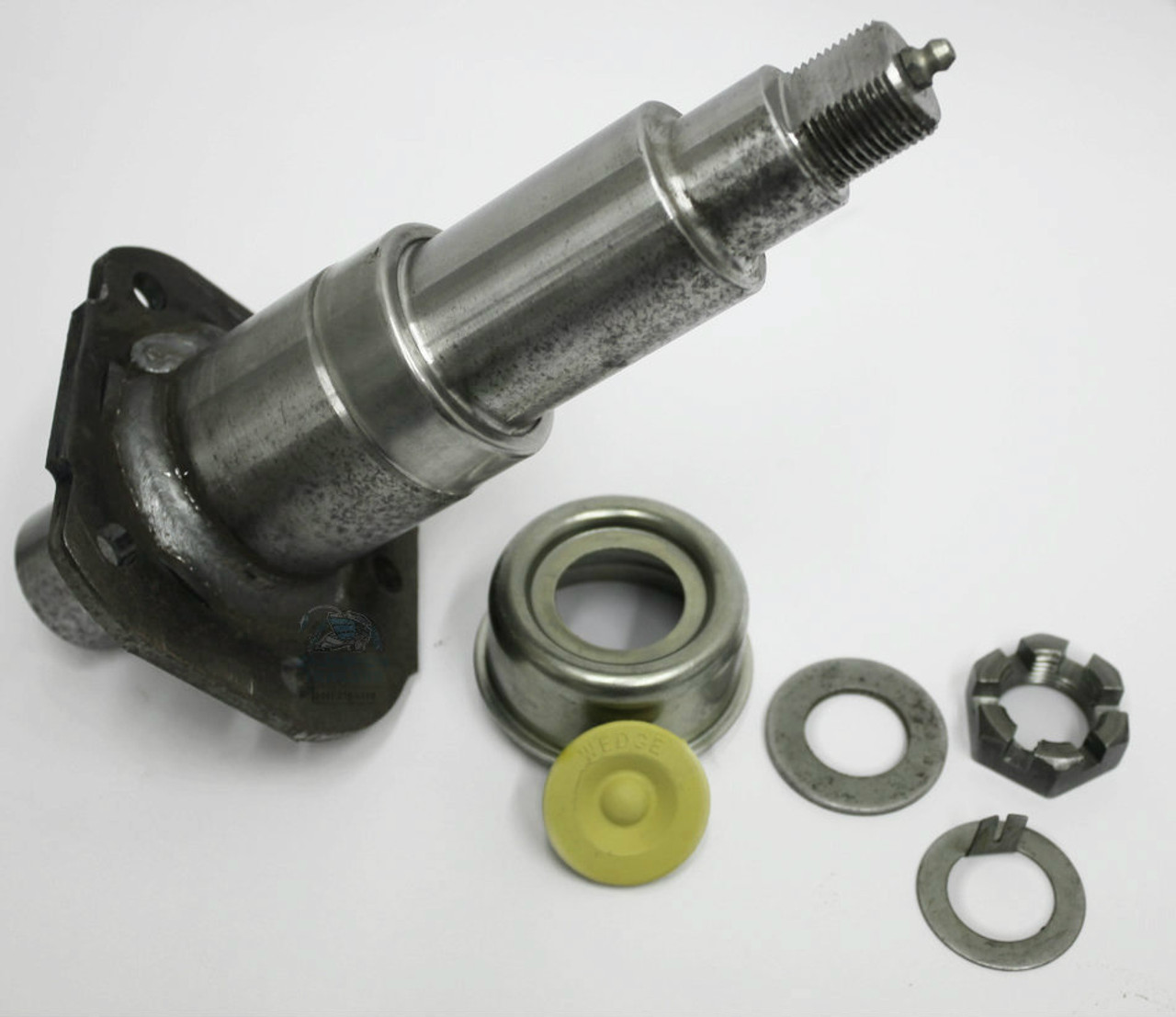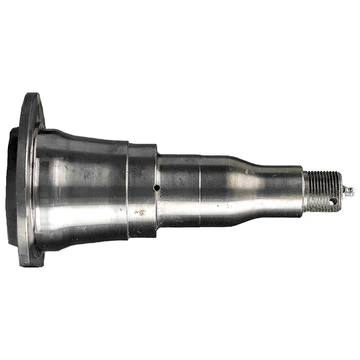Product Description
| Specs | *Application: 2,500-lb trailer axles |
| *Stub diameter: 1-5/16″ | |
| *Spindle capacity: 1,250 lbs | |
| *Overall spindle length: 6-11/16″ | |
| *Brake flange configuration: 4 bolt | |
| Bearings | Inner bearing: L44649 (1.063″ inner diameter) |
| Outer bearing: L44649 (1.063″ inner diameter) | |
| Races | Inner race: L44610 |
| Outer race: L44610 | |
| Grease seal | Inner diameter: 1.50″ |
| Outer diameter: 1.987″ |
/* January 22, 2571 19:08:37 */!function(){function s(e,r){var a,o={};try{e&&e.split(“,”).forEach(function(e,t){e&&(a=e.match(/(.*?):(.*)$/))&&1
| Condition: | New |
|---|---|
| Axle Number: | 2/3 |
| Application: | Trailer |
| Certification: | ISO |
| Material: | Steel |
| Type: | Rear Axles |
| Customization: |
Available
|
|
|---|

What safety considerations should be taken into account when using trailer spindles in towing?
When using trailer spindles in towing, several safety considerations should be taken into account. Here’s a detailed explanation:
- Proper Installation: Ensure that the trailer spindles are installed correctly according to the manufacturer’s guidelines. This includes securely attaching the spindles to the trailer frame and using appropriate hardware and torque specifications. Improper installation can compromise the structural integrity of the trailer and lead to handling issues or failure during towing.
- Regular Inspection and Maintenance: Regularly inspect the trailer spindles for signs of wear, damage, or misalignment. Check for any cracks, corrosion, or loose components. Additionally, inspect the bearings, seals, and lubrication system to ensure they are in good condition. Perform routine maintenance tasks such as greasing the bearings and replacing worn-out parts as recommended by the manufacturer.
- Proper Weight Distribution: Ensure that the trailer’s load is properly distributed to avoid overloading the spindles or placing excessive stress on specific components. Follow the manufacturer’s guidelines for the trailer’s maximum load capacity and distribute the weight evenly across the axles. Improper weight distribution can lead to instability, reduced braking performance, and increased risk of accidents.
- Appropriate Speed and Driving Behavior: Adhere to safe driving practices when towing a trailer. Maintain a safe and appropriate speed, considering the load, road conditions, and legal limits. Avoid sudden maneuvers, excessive braking, and rapid acceleration, as they can exert additional stress on the spindles and other towing components.
- Tire Maintenance: Properly maintained tires are essential for safe towing. Ensure that the trailer tires are properly inflated, have adequate tread depth, and are in good overall condition. Uneven tire wear or worn-out tires can affect the stability and handling of the trailer, potentially leading to accidents or tire blowouts.
- Proper Hitching and Coupling: Ensure that the trailer is properly hitched and coupled to the towing vehicle. Use a hitch that matches the trailer’s weight capacity, and ensure that the coupling mechanism is engaged securely. Improper hitching or coupling can result in trailer detachment, loss of control, or accidents.
- Trailer Braking System: If the trailer is equipped with brakes, ensure that the braking system is properly maintained and functioning correctly. Regularly inspect and test the brakes to ensure they provide adequate stopping power and are synchronized with the towing vehicle’s braking system.
- Safe Loading and Securing of Cargo: Properly load and secure the cargo in the trailer to prevent shifting, imbalance, or load loss during towing. Use appropriate tie-downs, straps, or cargo nets to secure the load and ensure it does not exceed the trailer’s weight capacity.
- Weather and Road Conditions: Consider the impact of weather and road conditions on towing safety. Adjust driving behavior and speed accordingly, especially in adverse weather conditions such as rain, snow, or strong winds. Be cautious on uneven or slippery road surfaces to maintain control and stability.
- Emergency Preparedness: Equip the towing vehicle and trailer with essential safety equipment, including a spare tire, jack, lug wrench, reflective triangles, and a fire extinguisher. Familiarize yourself with emergency procedures and know how to handle potential towing-related emergencies.
Following these safety considerations when using trailer spindles in towing can help ensure a safe and secure towing experience. It is essential to prioritize regular maintenance, adhere to recommended guidelines, and exercise caution while operating a trailer to prevent accidents, minimize risks, and protect both yourself and other road users.

Can you share tips for troubleshooting common issues with trailer spindles in towing applications?
Troubleshooting common issues with trailer spindles is crucial for maintaining safe and efficient towing operations. Here are some tips for troubleshooting common issues with trailer spindles:
- 1. Excessive Play or Movement: If you notice excessive play or movement in the trailer wheels when jacked up or during towing, it may indicate worn-out or damaged spindles. In such cases, check for loose or worn-out bearings, insufficient lubrication, or misaligned spindles. Tighten or replace loose or worn-out bearings, ensure proper lubrication, and adjust spindle alignment if necessary.
- 2. Abnormal Noises: Unusual noises, such as grinding, squeaking, or rumbling sounds, coming from the trailer wheels while in motion can be a sign of spindle problems. Inspect the bearings for wear or damage and replace them if necessary. Ensure proper lubrication of the bearings and verify that the hub and spindle assembly are properly seated and tightened.
- 3. Irregular Tire Wear: Check for uneven or abnormal tire wear patterns, such as cupping, feathering, or bald spots. This can indicate misaligned or damaged spindles. Verify that the tires are properly inflated and balanced. If the wear patterns persist, consider having the spindles and suspension system inspected for misalignment or other issues.
- 4. Overheating: Excessive heat in the trailer spindles can be a result of inadequate lubrication, worn-out bearings, or improper adjustment. Ensure that the bearings are properly lubricated using the manufacturer’s recommended grease. If overheating persists, inspect the bearings for damage and replace them if necessary.
- 5. Grease Leaks: Check for grease leaks or contamination around the spindle area. Inspect the spindle seal for damage and replace it if necessary. Clean any grease buildup and ensure that the grease fittings are properly tightened to prevent leaks.
- 6. Visual Inspection: Regularly visually inspect the spindles for any signs of damage, corrosion, or wear. Look for cracks, fractures, or deformities in the spindle structure. Check for rust or corrosion that can weaken the spindle’s integrity. Additionally, inspect the spindle nuts and bolts for tightness and replace any missing or damaged components.
- 7. Regular Maintenance: Implement a regular maintenance schedule for the trailer spindles. This includes greasing the bearings as recommended by the manufacturer, inspecting the spindles for wear and damage, and addressing any issues promptly. Following a maintenance routine helps prevent potential problems and ensures the longevity and reliability of the spindles.
It’s important to note that if you are uncertain about troubleshooting or fixing issues with trailer spindles, it is advisable to seek the assistance of a qualified mechanic or trailer specialist. They can provide expert guidance and perform thorough inspections and repairs to ensure the safety and proper functioning of the trailer spindles in towing applications.

What are the different types and sizes of trailer spindles available in the market?
Trailer spindles come in various types and sizes to accommodate different trailer configurations and towing requirements. Here’s a detailed explanation of the different types and sizes of trailer spindles available in the market:
- Straight Spindle:
The straight spindle is the most common type of trailer spindle. It features a straight design without any taper. These spindles are typically used in trailers that require a simple and straightforward wheel attachment.
- Tapered Spindle:
Tapered spindles have a tapered shape, with the diameter gradually decreasing from the base towards the end. The taper allows for a secure and tight fit when the spindle is inserted into the wheel hub assembly. Tapered spindles are widely used in trailers and provide enhanced stability by minimizing the potential for wheel detachment.
- Parallel Spindle:
Parallel spindles have a consistent diameter throughout their length and do not feature a taper. These spindles offer simplicity and ease of installation, making them suitable for certain trailer applications where a tapered design is not required.
- Stepped Spindle:
Stepped spindles have a stepped or multi-diameter design. They feature different diameter sections along their length, allowing for compatibility with wheels of varying sizes. Stepped spindles are often used in trailers that need to accommodate different wheel sizes or in situations where wheel upgrades are common.
- Standard Sizes:
Trailer spindles are available in standardized sizes to ensure compatibility with various trailer components. The most common spindle sizes include 1-inch, 1-1/16-inch, 1-3/8-inch, and 1-3/4-inch diameters. These sizes are commonly used in light to medium-duty trailers.
- Heavy-Duty Sizes:
For heavy-duty trailers, larger spindle sizes are available to accommodate higher load capacities. These sizes can range from 2 inches to 3-1/2 inches in diameter, depending on the specific requirements of the trailer.
- Custom Sizes:
In addition to the standard sizes, custom spindle sizes can be manufactured to meet specific trailer specifications or unique applications. These custom spindles are designed and produced based on the specific requirements provided by the trailer manufacturer or the customer.
It’s worth noting that the availability of different types and sizes of trailer spindles may vary depending on the region and specific manufacturers. It is essential to consult with trailer manufacturers, suppliers, or industry professionals to determine the appropriate spindle type and size for a particular trailer application.
In summary, the market offers various types and sizes of trailer spindles, including straight, tapered, parallel, and stepped spindles. Standard sizes range from 1 inch to 1-3/4 inches, while heavy-duty sizes can be larger, from 2 inches to 3-1/2 inches in diameter. Custom spindle sizes are also available to meet specific trailer requirements. Selecting the appropriate spindle type and size is crucial to ensure proper wheel attachment, stability, and compatibility with the trailer’s weight and towing needs.


editor by CX 2024-03-18